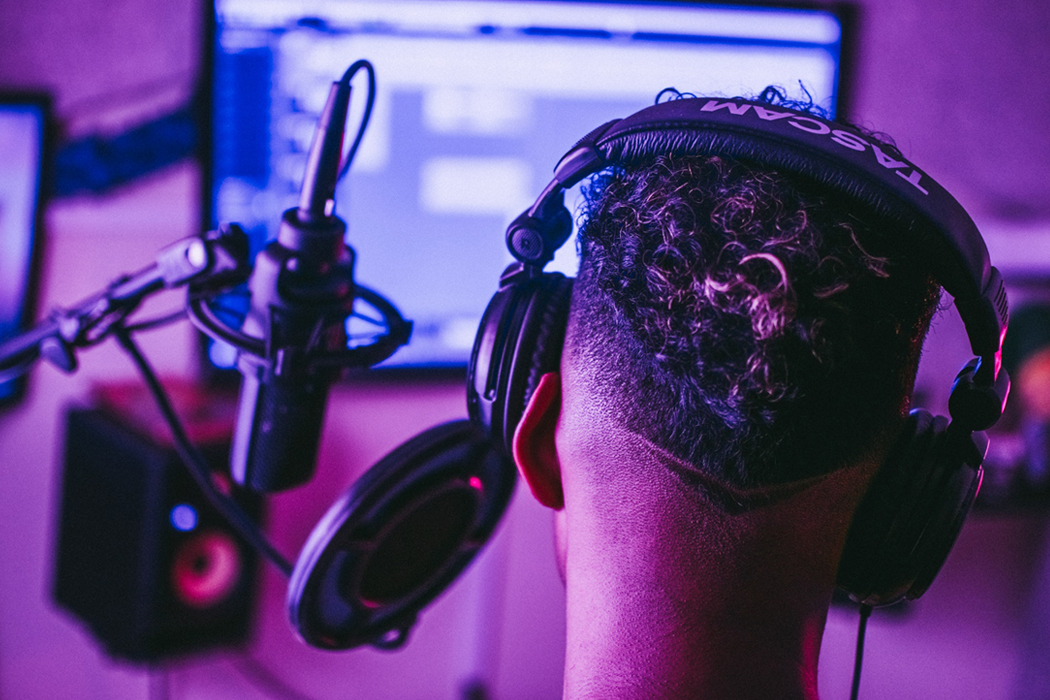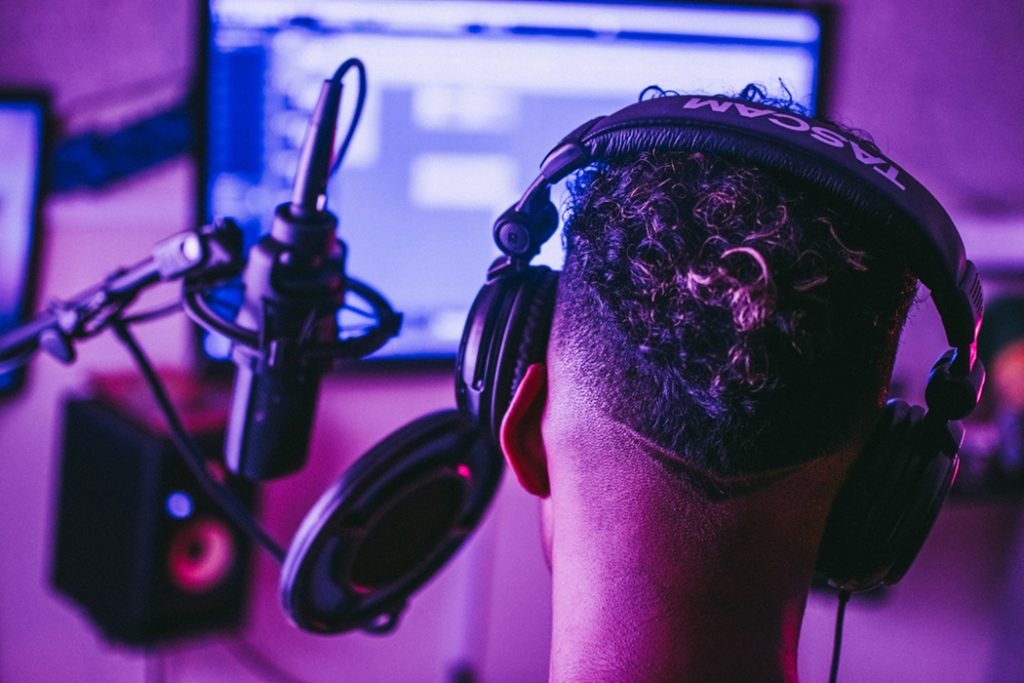
+ Learn the nuances of producing beats, arranging tracks, and creative sampling, drawing on the rich history and influence of hip-hop in Soundfly’s acclaimed online course, The Art of Hip-Hop Production.
Hip-hop has undergone a multitude of changes over the years since it first started making its appearance decades ago. But, regardless of those changes, one thing has always remained certain: hip-hop is all about the vocals.
And, of course, we recognize how crucial sampling is to the sound of hip-hop, or how important the drum patterns are, and especially nowadays how essential the bass groove is, but vocals still reign supreme when it comes to conveying your message. Without a story to tell, or a scathing earworm hook, or that one catchphrase that pervades throughout the next big trend, it wouldn’t be hip-hop.
So getting the vocal mix sounding right in a hip-hop track is of crucial importance. The process of mixing spoken or sung vocals can be summarized in three pretty general steps:
- Presence and Warmth
- Crispness and Clarity
- Balance with the Instrumental/Beat Track
Let’s get to each of these.
But first, if you’re producing hip-hop beats and looking for inspiration, creative alternatives, and to explore the work of one of the most influential beat makers of this century, look no further. Check out Soundfly’s new course with turntablist and sampling pioneer, RJD2: From Samples to Songs — he explores his creative process in detail, breaks down some of his most famous beats, and flips samples in real time.
1. Presence and Warmth
To begin with, start by examining the presence and warmth of the vocal track(s) in your mix. This typically means adjusting the compression settings on the vocal so that the sound is forward and clearly audible throughout the whole length of the track. Usually the attack time and compression ratio values are set fairly high for hip-hop vocals to give them additional forward presence in the mix. And the threshold and makeup gain values are set according to the specifics of each recorded track. You should strive for a strongly present, but not overly “in your face” feel to the vocals.
Then, adjust the EQ for sufficient bass and lower mid-range sound to give the vocals body, but avoid making them excessively ringy sounding. This generally means you will be making EQ boosts somewhere in the 80Hz to 300Hz range, but it varies from voice to voice.
For vocal doubles, ad libs, and backing voices, you may not want to push the compression and lower mid-range EQ quite as strongly in order to keep them more set back in the mix, behind the lead vocal.
Now that you have a warm and present sounding vocal, it’s time to ensure they have the crispness and clarity required for intelligible lyrics and to give a sense of bright airy-ness to the track. This can usually be accomplished through the addition of carefully selected upper mid-range and lower treble range EQ boosts, but there are also some vocal modeling and vocal effects plugins available that contain a variety of settings meant to help add a crisp feeling of air to vocal tracks.
If you use EQ to accomplish your task, you’re generally going to be looking at adding narrow bands of small EQ boosts in a few spots ranging between about 1kHz to 4kHz in order to add clarity. The goal of this step is to make sure consonant sounds (“k,” “d,” “t,” etc.) are clearly audible in the lyrics. If you’re unsure if you’ve applied it sufficiently, ask someone who hasn’t heard the track to listen back and see if they understood everything that was said. If so, you’re good — if not, you need to apply it more strongly or add some additional bands of EQ boosting.
2. Crispness and Clarity
For adding crispness and air to the vocals, you’ll be applying narrow EQ band boosts typically in the 4kHz to 8kHz range. This highlights the sibilant sounds (“sss,” “shhh,” etc.) and also breaths around the lyric phrases. A good hip-hop track sounds nice and crispy, but avoids excess sibilance that can feel hissy in the mix. You may find yourself adding EQ boosts within this lower treble range, and also applying a de-esser to control especially strong or long held out sibilant sounds.
It can be tempting to want to simply push the entire treble range up in order to achieve this crisp vocal sound, but this can then cause the vocals to compete with the treble percussion elements that occupy the higher treble ranges, so it’s best to avoid that easy way out and instead put the time and effort into carefully selecting lower treble range EQ boosts specifically targeted at vocal enhancement.
Before we cover the final step of balancing the vocals with the instruments, at this point we need to do a check for possible side-effects stemming from the adjustments we’ve made so far. In particular, with strong compression applied to add presence, it’s possible you’ll notice more background noises and mouth/breathing sounds in between vocal phrases. If so, you may need to apply a noise gate and/or do some editing work on the tracks to clean up these unwanted sounds. In addition, you may need to do some quick fade-in/outs of certain words and phrases to control these anomalies.
3. Balance
Now that we have our vocals nice and present, with full warmth and clarity, and a crisp airy feel to them; and we’ve cleaned up any unwanted side effects introduced during this process, it’s time for the final step of balancing the vocals with the instruments. There are three mixing adjustments we can make to ensure the vocals and instrumental sounds are balanced well with each other: levels, EQ, and panning.
Levels are the most obvious option; you want both aspects presented loud and clear, without either taking over the mix. It can be tempting to push the vocals much louder than the instruments, since this gives the impression of a loud-sounding mix, but that only takes you so far. For the most professional sound, aim for a balanced mix, even if it turns out a little quieter. Leave the volume boosting for the mastering step of your production, which is easier to do if you produce a balanced mix.
Even with properly level-balanced vocals and instrumental tracks, you probably will notice that they seem to compete with each other at times. This happens often in hip-hop since the instrumental beat tracks are usually composed entirely independent of the vocals and so there’s no way for the composer to know how to set the sounds for a vocal which doesn’t exist at the time it’s being produced. However, it’s usually not too hard to make room for your vocals within the balance of sound by EQing your instrumental beat tracks down a little in the mid-range frequency regions where both the instruments and the vocals have strong presence.
With a little trial and error, or with some assistance from a spectrum analyzer, you can find one or two small frequency bands in the mid-range, usually somewhere between 200-2,000Hz, that if you reduce them slightly in the instrumental tracks will open up quite a bit more space for the vocals to come through nicely. Remember, no matter how much you may like the instrument sounds, hip-hop is about the vocals!
Finally, take a moment to listen for any excess spatial overlap between the instruments and the vocals.
Did you pan a couple backing vocals or ad libs right on top of where a couple of the instrument sounds sit? You may need to alter them a bit so everything has its own separate place. Or perhaps you didn’t pan any of your vocals at all, and now the doubles and backing vocals are all buried behind both the lead vocal and beat sounds that are coming from the center stereo image. Go ahead and pan some of these supporting vocal tracks a little to each side so they contribute more noticeably to the whole vocal presence in relation to the beat.
If you take the extra time to go through each of these three steps carefully when mixing hip-hop vocals — presence and warmth, crispness and clarity, balance with the instrumental/beat track — you’ll be sure to make a great hit every time.
Don’t stop here!
Continue learning about beat making, sampling, mixing, vocal recording, and DIY audio production, with Soundfly’s in-depth online courses, including The Art of Hip-Hop Production, Modern Mixing Techniques, and RJD2: From Samples to Songs.




